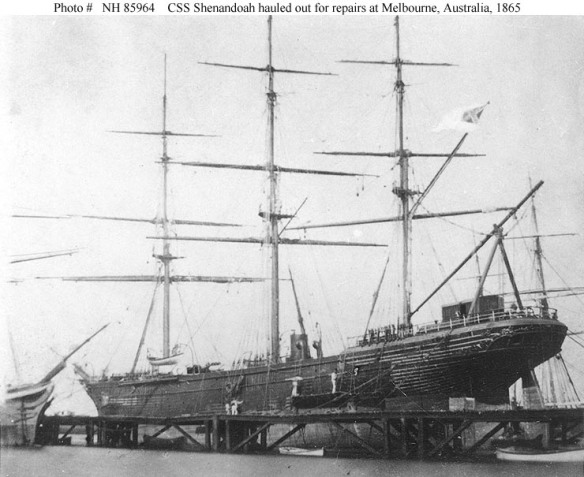The Confederate raider Shenandoah undergoing repairs in Melbourne, Australia. (U.S. Naval Historical Center)
Washington controlled 90 percent of America’s naval resources at the start of the Civil War. Therefore, the Confederate States Navy—created on February 21, 1861, two months before hostilities began—resorted to unconventional means. Jefferson Davis invited privateers to apply for licenses as early as April 17, two days before Lincoln announced a blockade of southern ports. This blockade quickly proved to be crippling. A few fast blockade-runners eluded patrols, yet bulk exports of cotton and tobacco were halted, strangling the Confederate economy.
Lacking heavy warships, the South’s best countermeasure was its privateers. Most initially operated out of New Orleans, then later along the Atlantic Seaboard. Their harassment of Union merchantmen was boosted when the 38-year-old Confederate commander James D. Bulloch reached Britain in June 1861 to act as a naval agent. In addition to purchasing arms and arranging cotton sales, he also secretly hired English shipbuilders (in violation of neutrality laws) to launch large vessels, which could then be sailed unarmed to a remote island and commissioned as Confederate warships.
The first such raider was named the Oreto, because it was supposedly intended for Italian service. After being launched at Liverpool and putting to sea on March 22, 1862, this swift 700-ton bark sailed for the Bahamas. John N. Maffi tt assumed command and renamed it CSS Florida. Nine guns were installed, but as the raider still needed more equipment, it departed on August 17 to fight its way past the Union blockaders into Mobile (Alabama). The Florida reemerged on its first commerce raid on January 16, 1863, claiming 47 prizes before putting into the French port of Brest on August 23.
Bulloch meanwhile arranged the launch of a 1,100-ton English sloop named the Erica on July 29, 1862. Less than one month later, it was commissioned as the 8-gun CSS Alabama under Capt. Raphael Semmes. He conducted a spectacular two-year cruise that claimed more than 60 prizes before being sunk by the U.S. sloop Kearsarge outside Cherbourg (France). Insurance rates for Union merchantmen soared, and blockading warships were diverted to pursue the elusive raiders. Finally, angry protests from Washington compelled the English and French governments to seize 6 more ships and 4 ironclads being privately built for Confederate agents.
The last raider acquired in England was the 1,200-ton, iron-framed Sea King, which was purchased in September 1864. It was met the next month at Madeira by the tender Laurel and was converted into CSS Shenandoah under Capt. James I. Waddell. Prowling into the North Pacific, Waddell netted 38 prizes and circumnavigated the globe before surrendering to the Liverpool authorities in November 1865. The Civil War had ended seven months previously. Washington sued London for hundreds of millions in compensation for the losses inflicted by English-built commerce raiders. An arbitration commission finally decided in September 1872 that Britain should pay the U.S. government $15.5 million to settle these so-called Alabama claims.
